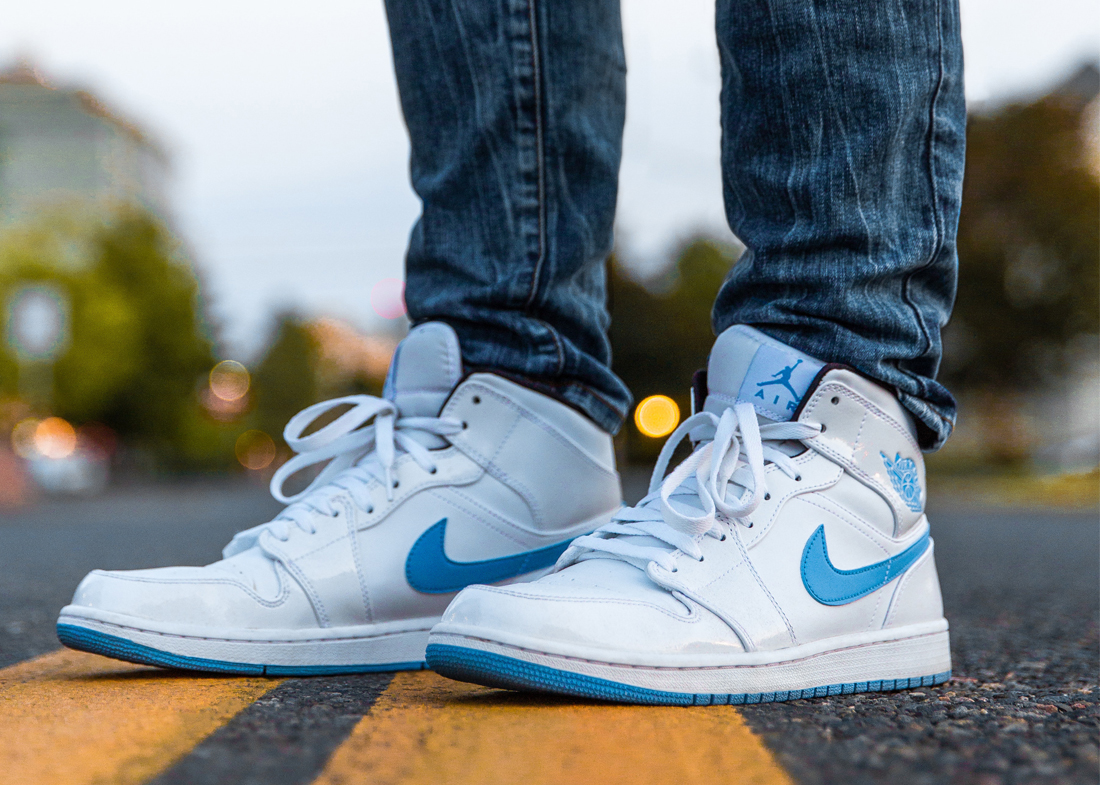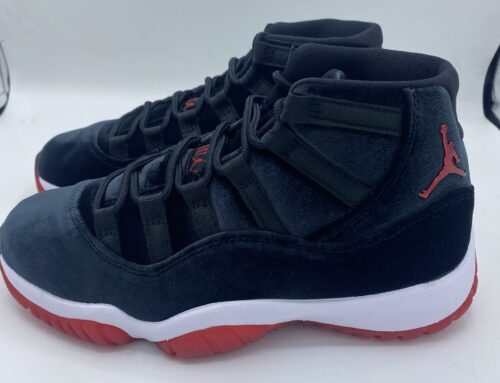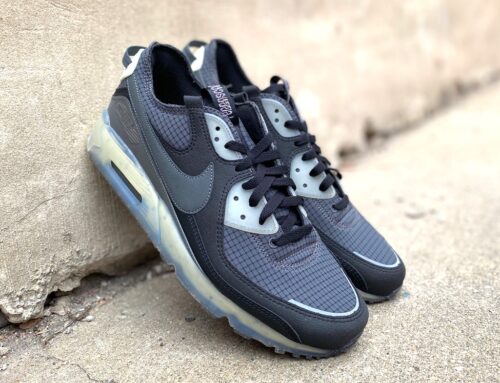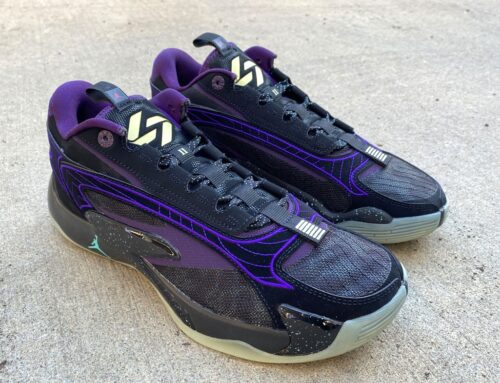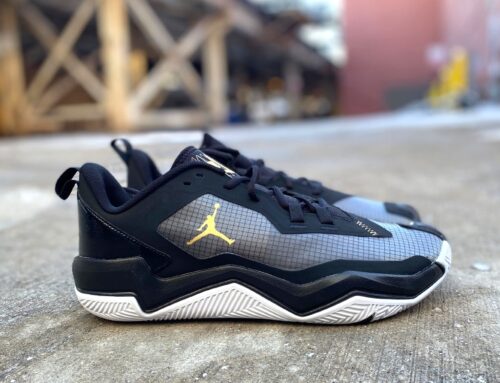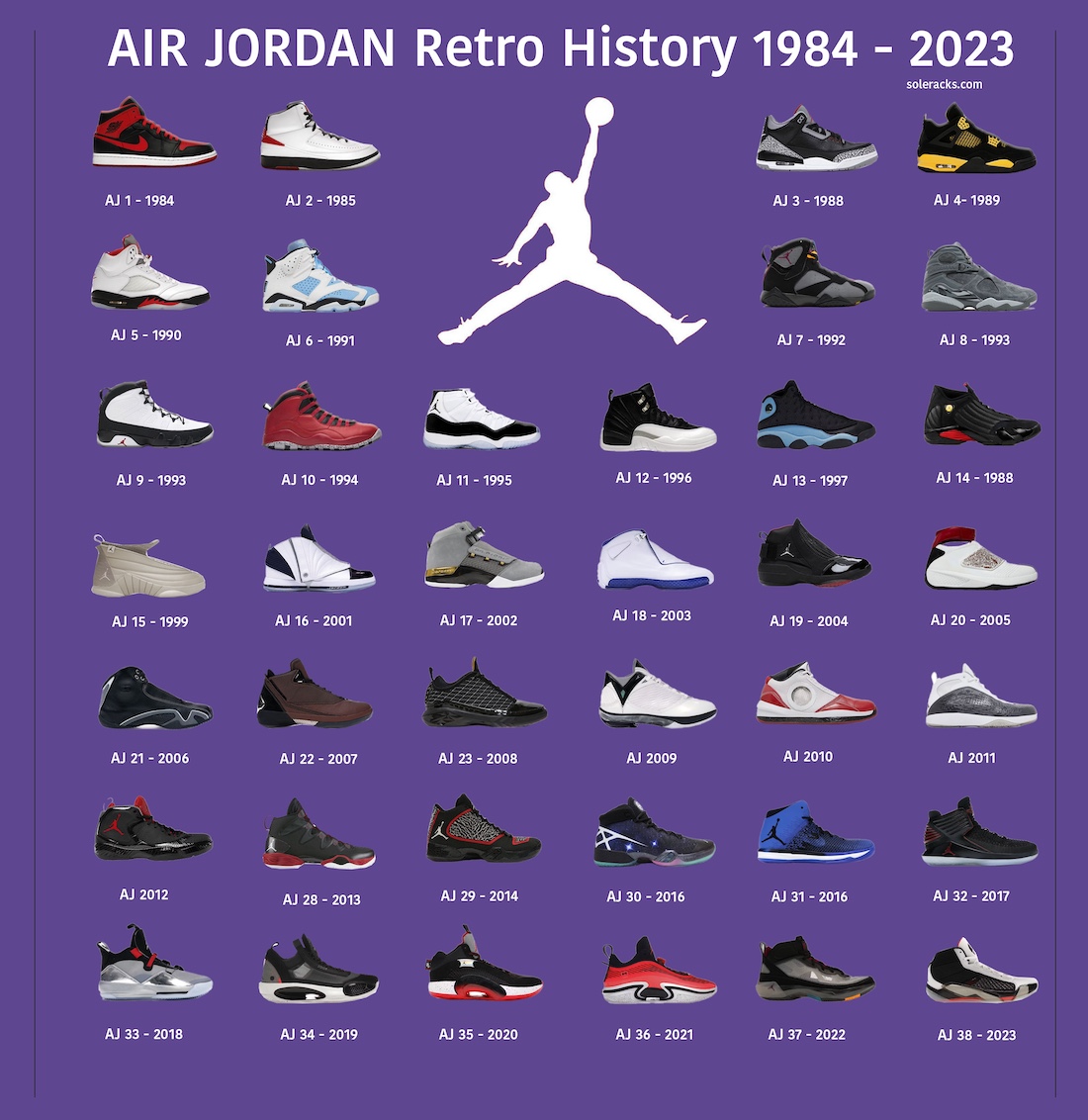
Today we’re taking a look at the history of the Air Jordan shoes series, without a doubt the most popular on the market today. When it comes on to sports, the Jordan name has long transcended the hard court and onto the streets in the form of an iconic line of Jordan retro sneakers. That’s right, Michael Jordan’s Air Jordan sneakers have not only changed the way the game of basketball is played, they have also revolutionized the shoe industry, particularly as it relates to the relationship between sports footwear and casual kicks.
Combining new air technology with sleek designs and unmatched durability, the shoes have maintained a loyal following over the 30 years since the very first one was released. With so many iconic editions to have been created, there is a favorite to match all tastes and preferences. In case you don’t know where it all started, here is an introduction to the evolution of the Air Jordan shoes series.
Air Jordan Retro Shoes History
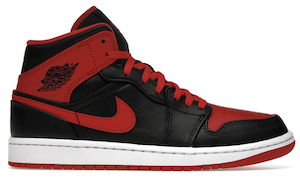
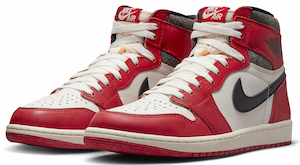
Air Jordan 1
1984
So, this is where it all started. It was the year 1984 and Michael Jordan’s career was about to take off, having just snagged a national title with the University of North Carolina and also won Olympic Gold with the national team. When the NBA Draft came around, MJ was not only 3rd selected by the Chicago Bulls, he was also signed by Nike in what was a lucrative deal at the time. In addition to millions of dollars, the player also got a shoe made in his honor. Modeled off previous Nike basketball shoes, the Air Jordan I came with Nike’s well-known air unit, a redesigned logo and clean lines that set it apart from the rest. Needless to say, not many people felt he deserved it due to his rookie status.
Not too long after, however, the basketball legend went on to prove his doubters wrong, doing so in his own pair of kicks. He also broke a few rules when he took the court in his first pair of AJs. Colored sneakers were not allowed in the NBA at the time, but the Air Jordan I was red and black, violating the rule before he even came onto the court. MJ was fined $5,000 for every game he played in that season but Nike gladly footed the bill because the shoe was a smash hit and helped MJ to a swell season.
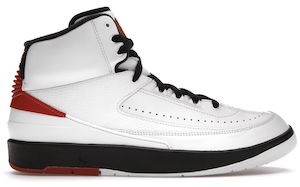
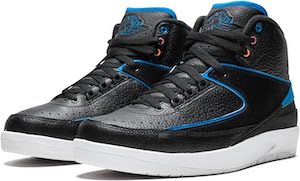
Air Jordan 2
1985
Emulating the success of the Air Jordan 1 was a hard act to follow but shoe designer, Bruce Kilgore, managed to pull off another masterpiece. He went for simpler lines than the AJ I and included a number of upgrades that later served MJ well while he recovered from a broken foot. The shoe featured a high-top cut with ankle support, full length air unit, faux lizard skin upper and a molded heel counter made of plastic, all of which provided enhanced comfort and stability. There was something else different about the Air Jordan II Retro sneaker, the Swoosh was not prominent on the upper.
In addition to the multitude of changes that set it apart, the Air Jordan II became special for one of MJ’s firsts; he won his first ever slam dunk title while decked out in a pair.
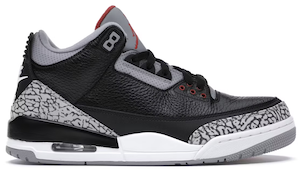
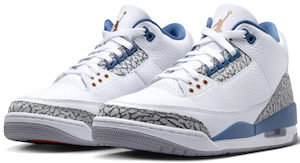
Air Jordan 3
1988
Possibly one of the most popular shoe in the line, the Air Jordan III marked another milestone in the sneaker industry. In addition to introducing the Jumpman logo, the shoe also introduced revolutionary materials and design elements which caused quite a stir in the footwear industry when it came out in 1988.
Quite a lot of thought went into the AJ III, which was designed by Tinker Hatfield. To begin with, newer advanced materials, such as luxurious tumbled leather, sculpted polyurethane and faux elephant skin, helped to give the sneaker a distinct look and feel. It was also the first in the line to have a visible air unit and the first mid-cut sneaker to be recognized as a basketball shoe. Michael Jordan’s career went to another level while wearing these shoes. He won season MVP, his second successive Slam Dunk title, and the league scoring title. His success and consequently, the success of the Air Jordan III, was further amplified by Nike partnering with Spike Lee for a TV commercial.
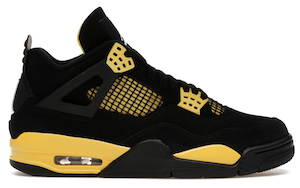
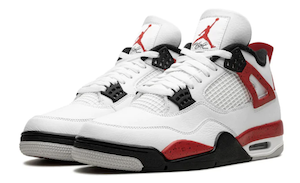
Air Jordan 4
1989
The fourth instalment of Air Jordan Retro sneakers in 1989 continued some of the design elements of its predecessor but was upgraded with little detail changes and the addition of nubuck. It was the first time the material was being used on a sneaker, adding to the revolutionary reputation of the line. Mesh was added to its upper for the first time, in addition to multiple plastic attachments that helped make the AJ IV more breathable and lighter than those that came before. Also, the now famous Jumpman logo had the word “Flight” added below it which may have been in reference to the Wings logo that adorned the first two AJs.
Once again, MJ was unstoppable on the courts in his technologically-advanced shoe that was as stylish as it was durable. The player won the league scoring title again and placed an exclamation mark on the season when he scored “The Shot”, which was a hanging jump shot over Craig Elho to win the first round of the playoffs for the Bulls.
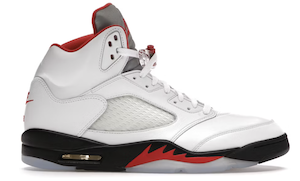
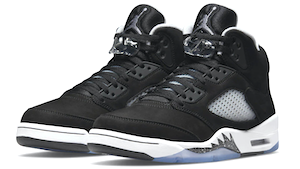
Air Jordan 5
1990
In an attempt to outdo himself, Tinker Hatfield took a different approach to designing the Air Jordan V. He carried over some of the standout elements from the AJ III and IV such as the visible air unit in the heel, sculpted midsole and breathable mesh but added translucent rubber to the mix. The shoe also featured an asymmetrical collar and reinforced heel that provided superior ankle support, a higher cut and a new pattern that took its design from a World War II fighter plane. If that was not enough, the Air Jordan V Retro Sneakers introduced a new colorway to basketball footwear in the form of grape purple/ emerald.
Other features that set the Air Jordan V apart from its predecessors include a raised tongue, reflective 3M material on some colorways, the words “Air Jordan” stitched onto the interior of the tongue, and lace locks for additional lockdown protection. MJ’s greatness continued to flourish while he wore the AJ V as he appeared in his sixth consecutive All Star Game, won another league scoring title, and made the All-NBA first team.
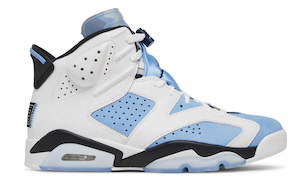
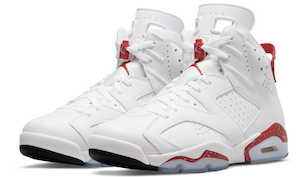
Air Jordan 6
1991
Another much-loved shoe in the AJ line, the Air Jordan VI came with a number of modifications that set it apart from its predecessors while maintaining some of the basics. Perhaps the biggest highlight of the sneaker being created was that it helped Michael Jordan win his first NBA title and Championship ring with the Bulls in 1991. He also continued to rack up a number of titles and awards, which made him the most influential player at the time. However, the shoe also gained further fame when it graced the feet of Jerry Seinfeld in his hit TV series and was later custom-built in the form of a boot for Michael Keaton’s Batman in 1992’s Batman Returns.
Several bells and whistles helped the AJ VI become one of the most visually-appealing sneakers at the time. They included a clean toe cap, lace locks, molded plastic heel tabs and a rubber tongue built with creative loops for the fingers. Additionally, the shoes used different materials on different colorways, with the most popular being leather and the eye-catching infrared/black colorway sporting suede.
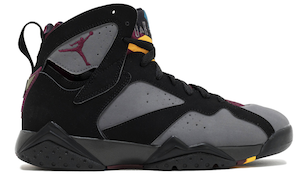
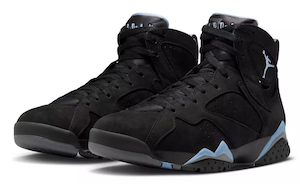
Air Jordan 7
1992
With Michael Jordan becoming his own brand, it was only natural that the Air Jordan VII of 1992 finally dropped Nike branding marks. The prominent swoosh was notably absent but that only gave space for Jordan’s famous #23 and the continued use of the Jumpman logo. It borrowed a number of design elements from the AJ VI, such as the upper and toe cap, but came with its own identity that was inspired by Nike’s Huarache basketball shoe series and the tribal culture of West Africa. The shoe was even lighter than previous designs with a thinner leather upper, but had hard plastic parts and an inner sock liner, which helped to comfortably wrap the shoe around the feet.
The Air Jordan VII also saw changes in marketing, pulling away from MJ’s collaborations with Spike Lee’s Mars Blackmon character to being seen with Bugs Bunny. On the courts, Jordan was now in full stride to becoming a hard court legend. In addition to winning his second Championship ring with the Bulls, Jordan also led the USA “Dream Team” to Olympic Gold at the 1992 Barcelona games. He also won his sixth consecutive scoring title, was named MVP, and made the All-star team once more, among other accolades, all while wearing the Air Jordan VII Retro Sneaker.
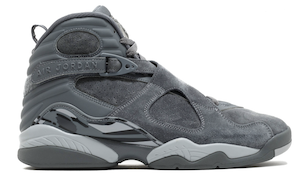
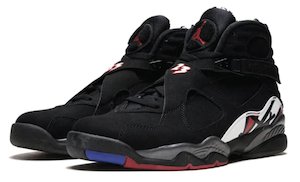
Air Jordan 8
1993
The Air Jordan VIII presented another pivotal period in His ‘Airness’ rich legacy with the Chicago Bulls. Not only did the sneakers provide another distinct design from the brain of Tinker Hatfield, they were built for high performance and saw MJ pulling off another brilliant season by leading the team to a third victory. It drew a lot of attention both on and off the courts and is remembered for being the first ‘three-peat’ AJ. It could well have been the last in the line of AJs as well since MJ left basketball the following year.
Regarded by sneaker fans as one of the most visually-stunning in the line, the original AJ VIII was available in three colorways, the black and white variations of the Bulls colors and the beloved Aqua version. Jordan helped to build hype around the sneaker by wearing the colors at different points in the season, with the Aqua being donned only once when he played in the NBA All-Star game. Other design elements that stand out on the sneaker include its unique lockdown strap, ‘bunny ears’ side straps and the super-imposed Jumpman symbol on the tongue which had now fully replaced the Nike Swoosh.
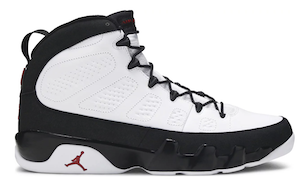
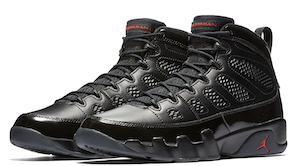
Air Jordan 9
1993
While the world waited excitedly for the release of the Air Jordan IX in the latter part of 1993, Michael Jordan dropped an unexpected bomb when he announced that he was leaving the game of basketball. Perhaps symbolically, Tinker Hatfield’s inspiration for the shoe was the baseball cleats Jordan wore when he decided to venture into minor league baseball, a childhood dream. They also had inscriptions of languages from around the world to pay homage to Jordan’s global status as a sporting icon. Nonetheless, the AJ IX was never worn on the court by the player they were named after, but by other NBA stars who had been inspired by the great.
The Air Jordan IX was another masterpiece addition to the line as far as design went. Its outer minimalistic features belied the technology that was packed beneath its insoles and within its unique upper construction. A classic high-top, it featured Nike’s signature Air technology in the heel and forefoot, the Jumpman logo on the lower heel, form fitting inner bootie, and single pull lace system. In honor of MJ, the shoe was chosen to adorn the player’s likeness, which stands outsides the Bulls’ home turf in Chicago.
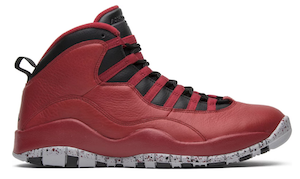
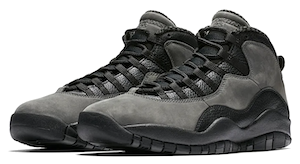
Air Jordan 10
1994
With His ‘Airness’ seemingly retired from the hard court for good, the Air Jordan X was built by Tinker Hatfield as a commemorative sneaker featuring a number of his achievements in previous years. However, the sneakers would turn out to be the comeback shoe for Michael Jordan as he made a glorious return to the game on the backend of the 94-95 NBA season. Although he lost his beloved number 23, he was still lethal on the courts in the AJ X.
The Air Jordan X was another well-built classic, with premium leather uppers, an advanced lacing system, full-length air cushioned sole and Huarache inner sleeve which had become the new standard for AJs. After a minor adjustment to the model, which saw the removal of the toe strap on subsequent releases of the very first Air Jordan X (a feature which MJ hated by the way), Michael Jordan announced that he was back and went on to pick up from right where he had left off.
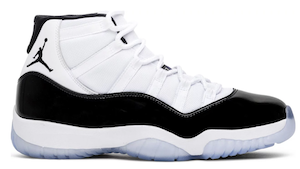
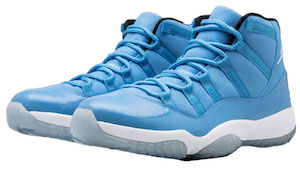
Air Jordan 11
1995
In the argument for most iconic Air Jordan sneaker, the Air Jordan XI, also known by sneaker lovers as the ‘Concord’, is one that will always come up for mention. The two main reasons for this are: just like the first AJ, it caused court controversy and got Michael Jordan fined; secondly, it revolutionized the way people wore and viewed sneakers. To be more specific, Jordan was fined $5,000 for two games for wearing all-white samples of the sneaker, which featured patent leather for the first time, before they were launched. That didn’t matter much, though, because when the shoes were eventually released to the public, the hype had built up to such a fever pitch that they sold out in no time.
As history will recall, the Air Jordan XI helped MJ and his team to a record-breaking season, ending with another hold on the NBA title. As it relates to design, the shoe’s main calling card was the patent leather on the upper which provides a better fit and a classy edge to the shoe. As a result, the sneaker redefined how people wore sneakers, ending up on the feet of patrons at unlikely events such as weddings and award ceremonies.
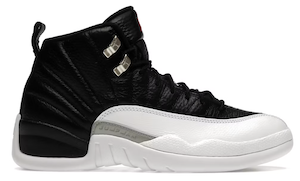
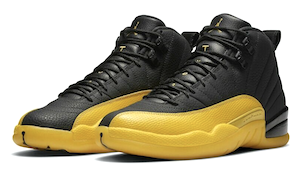
Air Jordan 12
1996
The first Air Jordan to feature Nike’s Zoom Air technology, the XII is also considered by many to be the most durable of the AJ line. It went back to an all-leather upper construction and, like many of its predecessors, had several symbols embedded into its architecture and quirky design elements that only true sneaker heads would understand or know about. They included a rising sun pattern, reminiscent of the Japanese, design inspiration from an old women’s shoe line, and the phrase ‘Two 3’ on the shoe’s tongue, which represents Michael Jordan’s player number.
Sleek, stylish and comfortable, the Air Jordan XII was a major hit on the courts, with not only MJ wearing them but his team mates as well. In fact, Scottie Pippen is said to have abandoned his very own signature sneaker for a pair of AJ XII during the 96-97 season. Outside the courts, the shoe was well loved by fans as well; so much so that when they were ‘retroed’ in 2003 and sold online, the Nike website crashed due to the level of increased traffic.
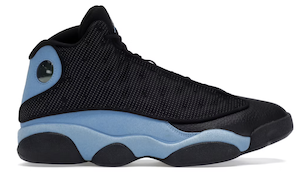
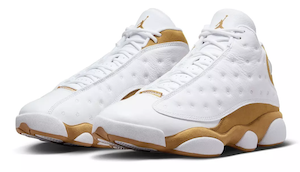
Air Jordan 13
1997
With Michael Jordan nearing the end of a highly-decorated career, the Air Jordan XIII was created by Tinker Hatfield to reflect his predatory persona on the court. As a result, the shoe’s design mimicked the Black Panther and came with a cat-eye hologram representing MJ’s fierceness on the courts. Although considered by many AJ lovers as one of the most underrated of the pack, the XIII still commands its place in history. It’s the sneaker Michael wore the most during another record-setting season as the team completed their second three-peat and was also the first to be sold under the Jordan name instead of Nike.
Featuring some of the design elements from the XI and XII, the Air Jordan XIII was also packed with technological features that placed it among the most lightweight and sturdy sneakers in its class. It came with an advanced carbon fiber spring plate, Zoom Air technology, recessed lacing system, and the unique Jumpman hologram. Worn for most of MJ’s last season with the Bulls, the original AJ XIII provided a fitting end to his career.
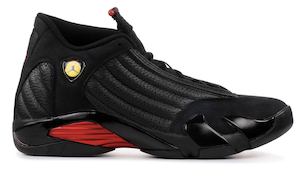
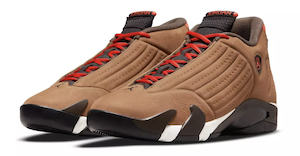
Air Jordan 14
1998
Inspired by Michael Jordan’s blazing Ferrari 550 M, the Air Jordan XIV just snuck in to be listed among the most iconic sneakers from the player’s illustrious career. In fact, although the XIII was supposed to be the shoe that closed out MJ’s time with the Bulls, the XIV stole its shine when it was debuted prematurely during the finals against Utah in 1998. Michael took what became famously known as the ‘Last Shot’ to win the series and the rest, as they say, is history…the XIV became legend and has seen numerous sellouts every time it has been ‘retroed’ since.
As mentioned earlier, the Air Jordan XIV takes much of its design cues from the Ferrari 550 M and has a ferocious look as a result. Underneath all that ferocity, however, the shoe is a hotbed of comfort and durability, featuring Zoom Air in the soles, full-grain leather upper with well-placed air vents, and a Jumpman logo which mimics the Ferrari shield.
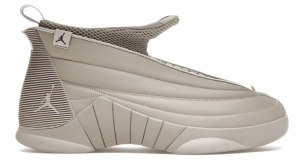
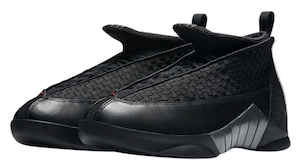
Air Jordan 15
1999
After Jordan retired from the NBA for the second time, many wondered if that was a signal for the end of his signature shoe line as well. With the Air Jordan XV already set to release, fans and sneaker lovers would have to wait to see if that was the case. One thing was for sure, however, this was the last AJ sneaker to be designed by Tinker Hatfield, ending a successful partnership that impacted the basketball game and fashion culture at the same time. While the shoe has held its own since its initial release, it is considered one of the least favored of the AJ kicks, probably due to its unconventional design or the fact that it signified life without MJ on the hard court.
Whatever the case, the shoe had a distinct, albeit stoic identity, hewn out of a design inspiration from the speedy X-15 aircraft, which was a NASA creation from the 1950s. It had a woven-pattern upper made from Kevlar, Zoom Air in the sole, concealed quick lacing, and an odd-looking tongue that many say is reminiscent of MJ sticking out his tongue when he played. More than anything, they represented Jordan as a full-fledged brand that had broken ties with the court.
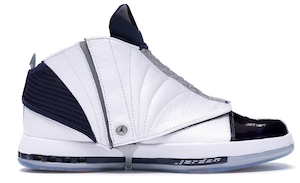
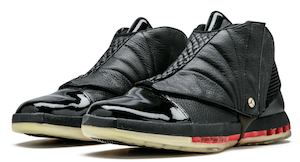
Air Jordan 16
2001
Although odd looking, the Air Jordan XVI turned out to be a hit, despite Michael’s noticeable absence from the basketball court and Tinker Hatfield no longer designing AJs. The shoe was the creation of Wilson Smith, who was a senior Nike Footwear Designer, and was composed of design elements taken from a number of other Air Jordan sneakers. Some of the most striking borrowed elements are the unique, removable shroud – also called a gaiter – which mimics the upper of the XIV; transparent rubber soles, borrowed from the V, VI and XI; and the patent leather toe box, which is the main calling card of the XI.
The Air Jordan XVI was released on a significant date, February 17th, which is Michael’s birthday, and is probably one reason why so much was put into its distinct design. Apart from the obvious parts, the XVI was also a technologically advanced shoe, with Zoom Air in the front and a molded Air unit in the heel, along with a special, breathable mesh material on the upper that helped the sneaker remain lightweight. Additionally, the patent leather front gave the XVI the same kind of fashion forwardness as the XI, meaning that it was paired with all kinds of clothing, including formal wear. However, it didn’t reach the level of popularity as the XI and had a few drawbacks, such as the shroud falling off and the shoe itself having a rigid feel.
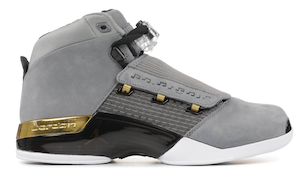
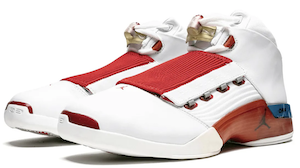
Air Jordan 17
2002
One of the most expensive Air Jordans at the time, the XVII signified the final return of Michael Jordan to the hard court in 2002; except this time, it was in the colors of the club he part-owned, the Washington Wizards. Nonetheless, the shoe was an appropriate welcome back symbol, sporting a number of bells and whistles that were befitting of a boss. Among them were a metal briefcase that the shoe was shipped in and a special compact disk in the lid of the case. The sneaker itself was quite eye-catching and drew inspiration from jazz music notes, the fine lines of a classic car (Aston Martin), and a golf course MJ had played on. Altogether, the design, which was another Wilson Smith creation, resulted in a sleek, unique shoe that featured a removable midfoot cover that was similar to the shroud of the XVI, full Zoom Air soles, leather uppers, and a sheath made from carbon fiber.
While the sneakers didn’t help MJ win the NBA and achieve accolades as with many of his previous signature shoes, they quickly became a collector’s item, thanks to the brief case presentation and the significant details of its design.
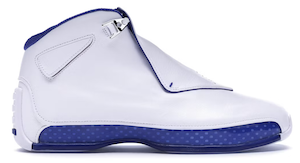
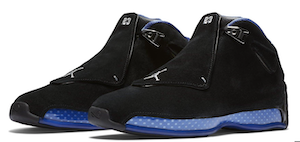
Air Jordan 18
2003
After the XVI and XVII, Wilson Smith was replaced by Tate Kuerbis, who had been part of the Nike setup since 1995 and worked with the AJ line since 1999. His design for the XVIII not only gave a fresh, modern look to the sneaker, it also incorporated one of Michael Jordan’s passions, race cars. In fact, the shoe was built to mimic those used by race car drivers and its all-in-one construction was based on carbon fiber, which represented the body of a formula 1 racing car. However, not all the design elements were from speeding cars, it also had bold stitching which borrowed from high fashion Italian dress shoes. Other features which enriched the XVIII were its Zoom Air sole, air vents, its hidden speed-lace system and its suede leather uppers. Additionally, while they didn’t come in a boss-like briefcase like the XVII, they were sold in a specially designed, slide-out box that also contained a brush, a towel and a mock driving manual for the AJ XVIII.
The XVIII would be the sneaker in which Michael Jordan closed the curtains on his career for the final time. He didn’t play out the entire 2002-2003 season with the Wizards due to injuries but still gave a good account of himself. As a result, the shoe became highly sought-after as it was the final shoe that the legend wore while playing professional basketball. One of the most coveted was a black and blue colorway which MJ sported on court.
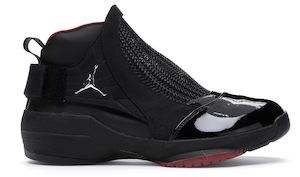
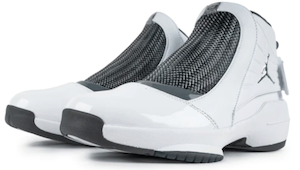
Air Jordan 19
2004
Michael Jordan’s career was now truly over but that didn’t stop him from being represented on the hard court in the likeness of his signature shoe line. When the XIX was released in 2004, a number of top players in the game at the time, including Gary Payton, Jason Kidd and Ray Allen, received exclusive versions of the shoe in order to help promote it. Another Tate Kuerbis led creation, the sneaker is regarded as one of the most technologically advanced, supportive and lightweight shoe in the entire line of AJs. It is also highly unique in that it is the first original Air Jordan to not come with laces. Instead, it is constructed with a specially-made sleeve, made from a high tech material and has a braided design that locks the shoe onto the feet.
The shoe’s advanced comfort is supported by dual air units in the heel and a full length Zoom Air casing. On the outside, the Air Jordan XIX is all sophistication and class, centered around the flexible braided sleeve. Its aesthetics were inspired by a notoriously dangerous snake, the Black Mamba, and like a few of its predecessors that have been paired with formal wear, has patent leather on the front.
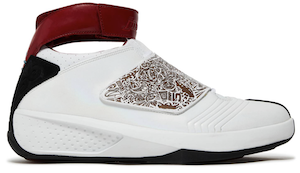
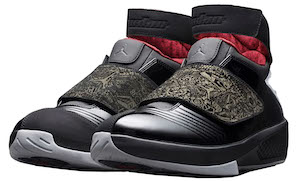
Air Jordan 20
2005
One of the most symbolic in the line, the Air Jordan XX is a delectable mix of state of the art technologies and historical ties to Michael’s long list of achievements as a basketball player and businessman. Tinker Hatfield came back in the driver’s seat for this special AJ sneaker and he pulled out all the stops to make it a memorable shoe. To begin with, the AJ XX drew inspiration from cycling, namely the shoes and tires. The shoes main feature, however, is a midfoot lace cover, which has a number of symbols related to MJ’s career, laser-etched onto it. Only MJ fanatics can actually decipher all the symbols.
A unique ankle strap also set the Air Jordan XX apart from the others, in addition to the fact that it was the first AJ to feature Independent Podular Suspension (IPS) technology, which focused on providing support for the different areas of the foot. The outside of the shoe, depending on the colorway, is composed of a mix of full grain leather, nubuck, and patent leather. One of the most famous colorway from the AJ XX is the ‘Stealth’, which is predominantly black and grey.
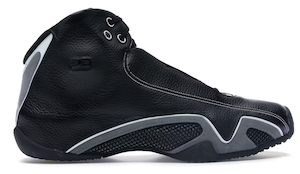
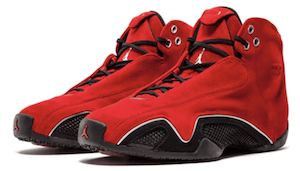
Air Jordan 21
2006
Michael Jordan’s love for flashy cars would once again be demonstrated in the design of another of his signature shoes, as the AJ XXI took cues from the Bentley Continental GT Coupe. It was created by D’Wayne Edwards and featured a more simplistic design than the previous five AJs. That does not mean the Air Jordan XXI is a simple shoe; it is bold and brash, on the contrary, and is said to represent the champion DNA of MJ himself.
Released a day after Michael’s birthday in 2006, the shoe incorporated a number of technological advancements that represented the future of high performance footwear. The IPS tech that was introduced in the XX was now supported by other advanced features, including a customizable Zoom Air pillar in the heel, breathable textile material on the forefoot, quilted collar backed with foam for ultimate comfort and cushioning, along with carbon fiber midfoot and arch supports.
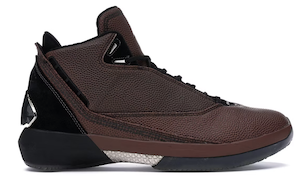
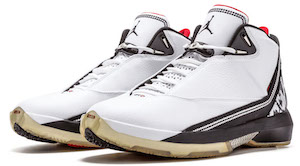
Air Jordan 22
2007
Inspired by another technologically breathtaking piece of machinery, the Air Jordan XXII was modeled off the F22-Raptor fighter jet and was launched on MJ’s 44th birthday. Not only did it capture some of the design features of the aircraft, it was also built to emulate the indomitable spirit of Michael Jordan when he ruled the courts. Its cutting edge design includes titanium parts (the chemical formula for titanium is 22 by the way), air vents which help to cool the feet, and a podular outsole that offers enhanced traction and control on the court.
The Air Jordan XXII is also listed among the most comfortably cushioned sneakers in the line. This reputation is backed by the IPS system that featured prominently in the XX and XXI, along with an ankle support apparatus that many regard as the best of all the AJs. Other standout features that have placed the shoe on must-have lists for Air Jordan enthusiasts include an extended heel counter for added stability, intelligent lacing, and a high quality, stitched leather upper with strategic markings to give it the MJ edge and distinction.
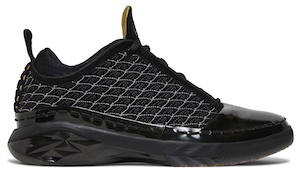
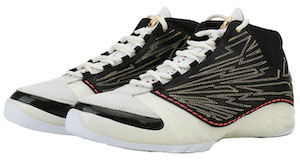
Air Jordan 23
2008
The number 23 will forever be associated with Michael Jordan due to his prowess on the basketball court. As a result, when the time came to make the 23rd edition of his Air Jordan line, it had to be something special. Tinker Hatfield, the man who had been behind most of the standout designs, was also the architect of this shoe. Based on the results, he failed to disappointment once more.
One of the most technologically-advanced sneakers of its time, the Air Jordan XXIII was the first in the line to be based on the Nike Considered Design system, which focused on reducing waste during product development. The shoe turned out to be as stunning in design as it was in comfort and durability.
From the specially spray-painted TPU midsole to the 3-D stitched upper, a lot of time was spent ensuring that the Air Jordan XXIII was different from anything else available. Additionally, it had MJ’s personal touches strategically placed, such as his signature on the toe cap and the pattern of his thumbprint on the outsole. A full-length Zoom Air unit and innovative Independent Podular Suspension (IPS) also ensured superior cushioning for the wearer. Overall, the shoe reflected MJ’s love of performance shoes which could also be dressy.
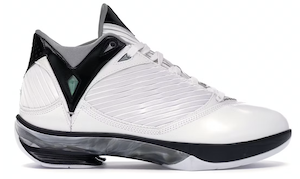
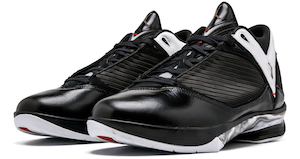
Air Jordan 2009
2009
Referred to as the Air Jordan 2009, the first Jordan Brand shoe to adopt the year as a model, the AJ XXIV was designed to be a basketball kick that was more original than other sneakers that were in existence at the time. It is said to be inspired by Michael Jordan’s undying spirit and will to achieve. Like many before, it debuted another innovation in shoe design in the form of Articulated Propulsion Technology. This new platform involved a game-changing heel system and design elements that promote comfort while encouraging explosive speed and agility on the court.
Also like its predecessor, the Air Jordan XXIV was based on the Nike Considered Design system which was geared at protecting the environment without affecting athletic performance. It featured a contoured construction to match the athlete’s foot and provide unmatched support. TPU in the midsole provides needed rigidity while foam inserts promote cushioning and impact protection. In addition, polished leather on the outer shell of the shoe allows wearers to easily transition from casual to formal. With all its features, the AJ XXIV was well-received by Air Jordan lovers and basketball players.
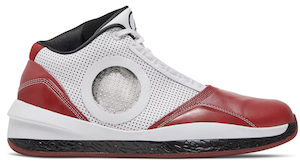
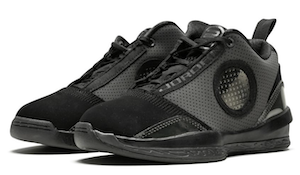
Air Jordan 2010
2010
The 2010 edition of the Air Jordan represented the 25th anniversary of Michael Jordan’s signature shoe and carried on his legacy of high quality, technologically-advanced basketball kicks. To signify the quarter century mark, a lot of thought went into the sneaker, like many of the milestone shoes in the line, and Tinker Hatfield was brought in to work his magic once more. This time, however, he received help from Mark Smith and the result was a futuristic sneaker from the Jordan Brand that was highly anticipated by sneaker lovers everywhere.
One of the standout design features of the Air Jordan XXV is a transparent window around the ankle area, which is made from TPU. This, along with its numerous high performance components ensured that the shoe made its mark and stood testament to the evolution of the Air Jordan line. Other notable features of its simple but compact design included a detachable overlay, a memory foam sock liner for enhanced comfort, and heel guards to help keep the shoe’s shape. In addition to that, the new loaded zoom midsole provided cushioning like none before. Available initially in black/white/red colorways, the sneaker was also a hit on the streets as well as on the courts with players such as Dwayne Wade.
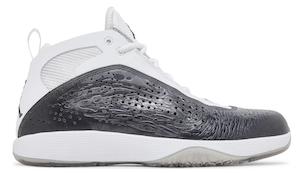
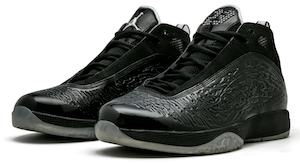
Air Jordan 2011
2011
Highly rated as one of the best Air Jordans to have been made in recent times, the AJ XXVI (Air Jordan 2011) was another shoe that was all about on-court performance but had strong style elements at the same time. Like its predecessor from the Jordan Brand, the shoe was introduced to the world on the feet of basketball superstar, Dwayne Wade. Among its many standout features included interchangeable insoles to provide different types of cushioning to match the feet and style of play, along with a one-piece hand-crafted leather band that added character and form to the overall girth of the shoe. This type of leather actually ensured uniqueness – so no two pairs of shoes were exactly alike.
With several of its outer features mimicking that of the famous Air Jordan XI, which was nicknamed the Concord, the sneaker was seen as the perfect balance between performance and style. Its sock liner provided a great amount of cushioning, which was further enhanced by the Zoom Air in the midsoles and sturdy outsoles. In fact, the elephant pattern on the outsoles provided superior traction, finishing off the performance package.
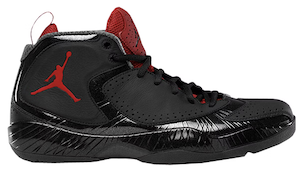
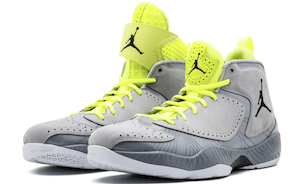
Air Jordan 2012
2012
The fourth shoe in the line to adopt the year it was released rather than the traditional number (XXVII), the Air Jordan 2012 came with a number of bells and whistles intended to shake up the basketball shoe community once more. It was another technological masterpiece from the mind of Tinker Hatfield, along with help from Tom Luedecke, and also featured a modular design similar to the 2011 Air Jordan. It was also the first Air Jordan to actually let the wearer ‘Choose your flight’ due to its interchangeable insoles and midsoles.
Strong and lightweight was the name of the game, resulting in Flywire making up the shoe’s upper, along with lightweight, premium suede and leather overlays. The whole shoe was breathable and its raised tongue added an air of sophistication. These, along with its carbon base ensured quickness and performance on the courts like never before and made the Air Jordan XXVII a favorite among the modern crop of Jordan Brand kicks.
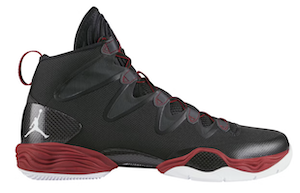
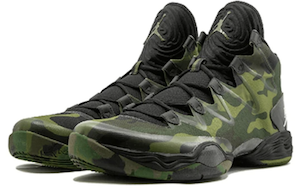
Air Jordan 28 (XX8)
2013
After the AJ 2012, the Jordan Brand went back to its traditional numbering system with the Air Jordan XX8 (28). The shoe also adopted a more rugged look compared to its last four predecessors but that did not take away from its technologically-packed construction and the fact that it was another shoe built for hard court performance. One of the design elements of the shoe which ensured that it was a head turner was a zippered shroud-like attachment which, when removed, revealed a quick lace system.
Regarded as the lightest Air Jordan up to that point, the AJ XX8 was also designed to be among the most durable. It included breathable carbon heel counters, zoom air mesh, zoom air in the front and heels, a high traction, translucent rubber outsole, and Flight Plate tech to add the kind of support needed during competition. Like the previous shoe in the line, the AJ XX8 had an extended tongue which gave it a look of a stylish boot.
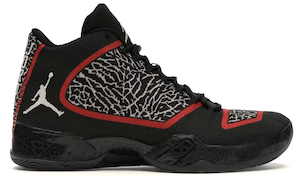
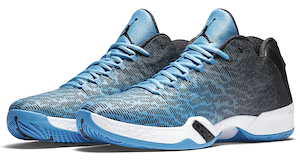
Air Jordan 29 (XX9)
2014
The release of the Air Jordan XXIX ended the reign of its predecessor as the lightest AJ ever as it was built to be a lightweight super shoe. Incorporating advanced technologies, such as an enhanced Flight Plate and Flyweave material, the sneaker gave players freedom to move on the hard court while providing seamless cushioning.
Like most of the shoes in the Jordan Brand line, the Air Jordan XXIX was designed by Tinker Hatfield and captured Michael Jordan’s character and fighting spirit. The elephant pattern, which had been used on other AJs, was a standout feature of this particular shoe, as well as its innovative Flight Web system for added support, along with breathable mesh upper. In addition, the sneaker offered a high traction, patterned outsole and web-like straps to provide a snug and superior fit. With more than a year since the release of this shoe, the AJ XXIX continues to keep fans happy as Jordan sneaker fanatics watch and wait for the next edition.
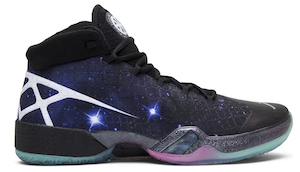
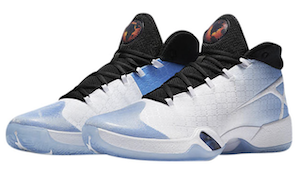
Air Jordan 30 (XXX)
2016
The Air Jordan XXX, released on February 12, 2016, marked a pivotal moment in the evolution of Michael Jordan’s signature sneaker line. Crafted under the creative guidance of Tinker Hatfield and Mark Smith, the AJ XXX built upon the innovations of its predecessor, the AJ XX9. Drawing inspiration from a memorable 1988 slam dunk contest moment, where Jordan soared to the hoop, Hatfield and Smith designed the shoe to seamlessly blend the proven elements of past models with contemporary flair.
Breaking down the AJ XXX into five key categories, Hatfield and Smith incorporated design elements reminiscent of iconic predecessors. The asymmetrical collar, reminiscent of the AJ XII, married ankle support with flexibility. The specially designed toe, influenced by MJ’s preference for a “toe down” look, drew inspiration from the XI’s patent leather rand. Maintaining the successful FlightSpeed technology from the XX9, the AJ XXX featured a modified FlightPlate for enhanced traction. The one-piece upper, combining woven and knit materials, prioritized both performance and design innovation. With a “galaxy” visual element on the midsole and a balance between familiar features and fresh design, the Air Jordan XXX upheld the legacy of its predecessors while propelling the line into the future.
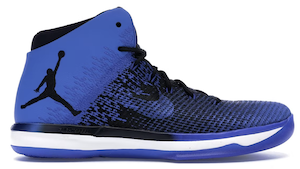

Air Jordan 31 (XXXI)
2016
The Air Jordan XXXI, unveiled by the Jordan brand in July 2016 and released in September of the same year, marked the onset of a new era in on-court performance footwear. Designed by Tate Kuerbis, the XXXI paid homage to its iconic predecessor, the original Air Jordan, by incorporating elements like a higher top for increased ankle support and a lower-profile midsole for heightened responsiveness on the court.
In a forward-looking move, Kuerbis seamlessly blended old-school leather with cutting-edge Flyweave technology, derived from aerospace techniques. This innovative combination offered a lightweight yet robust upper, providing flexibility in the forefoot and support in the heel. The ankle collar, designed to optimize fit and lockdown, strategically reduced foam for a balanced blend of padding and support.
The midsole featured Nike’s FlightSpeed system, engineered to enhance athletes’ explosive first step and boost in jumps and jump shots. The color gradient midsole and various colorways, including monochromatic and translucent “frosty” outsoles, showcased the AJ XXXI’s versatility and design innovation.
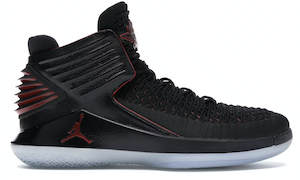
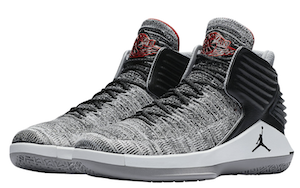
Air Jordan 32 (XXXII)
2017
The Air Jordan XXXII, a pivotal edition in the iconic line, brought a fusion of heritage and cutting-edge innovation. Designed by Tate Kuerbis, the mind behind the Air Jordan XVIII, XIX, and XXI, the XXXII drew inspiration from the Air Jordan II, tracing back to the roots of the Jordan legacy. The XXXII mirrored the sloping lines of the II, expanding and evolving the horizontal fins across the Achilles. Introducing a Flyknit upper for the first time in the Air Jordan series, the XXXII combined high-tenacity yarn for stretch, support, and zonal lockdown, ushering in a new era of flexibility, comfort, and performance.
Underlining its commitment to performance, the XXXII featured tuned-up Flight Speed technology and a midfoot carbon-fiber plate housing low-profile Zoom Air units, akin to the revolutionary Air Jordan XX8. The shoe’s aesthetics seamlessly integrated functional elements, with the Wings logo on the tongue, concealed laces within the Flyknit upper, and a distinctive herringbone traction pattern on the outsole. Notably, the XXXII marked a global release in both mid and low versions, solidifying its place in Air Jordan history
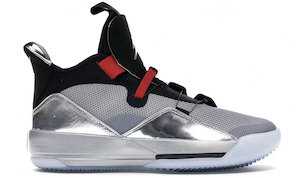
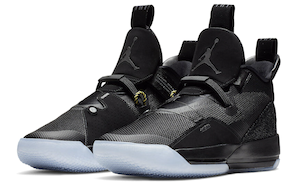
Air Jordan 33 (XXXIII)
2018
The Air Jordan XXXIII, unveiled on October 18, 2018, epitomized the Jordan brand’s commitment to merging style and function, introducing Nike’s groundbreaking FastFit technology. Designed by Tate Kuerbis, the XXXIII departed from conventional laces, adopting a pull-to-adjust system tailored for players—loosen during rest, cinch up for game time. Featuring loops on the tongue and heel for easy entry, the tightening system offered 360-degree lockdown with a single tug, allowing swift ejection and relaxation by pulling the side cables.
Kuerbis drew inspiration from space suits, evident in the shoe’s utilitarian design showcasing pull cords and an intriguing circular window in the outsole, unveiling the inner workings of the FastFit system. The XXXIII paid homage to past legends with nods to iconic models, incorporating design elements from the AJ III, IV, V, VI, and the Air Jordan 2010. FlightSpeed technology, with a carbon fiber plate and Zoom Air, enhanced energy return, embodying the Flight Utility philosophy of creating performance art. Kuerbis’s visionary approach, inspired by diverse sources, epitomized a leap of faith into the future, blending innovation and function in the pursuit of unparalleled design.
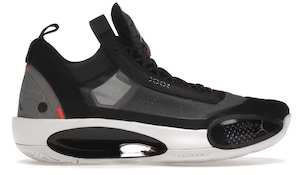
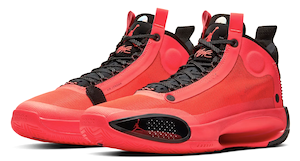
Air Jordan 34 (XXXIV)
2019
For the Air Jordan XXXIV, designer Tate Kuerbis returned with a mission to enhance traction and reduce weight, addressing athletes’ specific needs. Marking his fourth consecutive design for the Air Jordan series, Kuerbis introduced the innovative Jordan Eclipse Plate, an evolution of the Flight Speed Plate. Comprising two Pebax polyurethane plates forming a hollow core, this design prioritized weight reduction, making the XXXIV one of the lightest Jordan models at 13.1 oz. The Jordan Eclipse Plate ensures a seamless transition from midfoot to forefoot, offering precise control during rapid movements.
Beyond performance, the XXXIV captivates with a vibrant upper, drawing attention to MJ’s signature sneakers. Intricate details include the Morse code depiction of ‘Number 23’ at the bottom of the laces, variable branding on the heel based on colorways, and a symbolic ‘J4-34, 2.89-2019,’ referencing the 30th anniversary from IV to XXXIV. Whether on the court or off, the XXXIV stands out, endorsed by basketball stars like Zion Williamson, Blake Griffin, and Jayson Tatum.
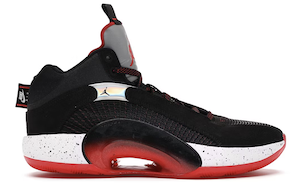

Air Jordan 35 (XXXV)
2020
Celebrating 35 years of groundbreaking performance, the Air Jordan 35 ushers in a new era for the Jumpman. Building on the revolutionary tech of its predecessor, the Air Jordan 34, the 35 refines the Eclipse Plate to deliver an unparalleled fit and feel coupled with explosive cushioning. Jordan Brand president Craig Williams emphasizes the significance of the Air Jordan signature shoe, reaffirming its central role in the brand’s commitment to excellence on the court. At the heart of the 35’s design is the Eclipse Plate 2.0, a cored-out TPU shank unlocking maximum bounce from Zoom Air units in the forefoot and heel. The addition of “Flight Wire,” an evolution of Nike’s iconic Flywire tech, provides versatile support.
Visually, the Air Jordan 35 seamlessly blends traditional leathers and suedes with modern synthetics, featuring tongues and heel moldings inspired by the Air Jordan 5. Designer Tate Kuerbis underscores the priority of integrating premium materials, emphasizing their aspirational quality and the brand’s commitment to crafting the best basketball shoe on the planet.
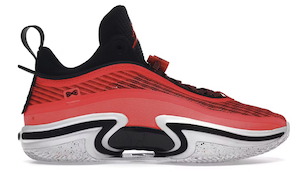
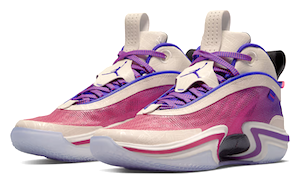
Air Jordan 36 (XXXVI)
2021
The Air Jordan 36 marks another stride in Jordan Brand’s commitment to evolving basketball footwear technology, emphasizing the key ethos of “light.” Engineered by various design teams, the shoe features a jacquard leno-weave upper, providing wearers with enhanced breathability and a lighter feel. The emphasis on teamwork and product excellence is central to the design philosophy, as highlighted by Martin Lotti, VP of Jordan Brand Design, reflecting the collaborative effort to carry Jordan’s legacy into the future.
Intricate details pay homage to the Air Jordan 6, the shoes in which MJ secured his first championship. Elements like the lace shroud, cutouts on the treading, and heel furnishings evoke the spirit of the iconic model. Departing from the exposed Zoom bags of its predecessors, the Air Jordan 36 introduces a ribbon-foam material throughout the midsole, covering the plate system and subtly incorporating details from the Air Jordan VI. Jordan Brand Footwear Designer Tate Kuerbis explains the shift, emphasizing a desire to connect the ribbon and highlight Michael’s enduring influence on global culture.
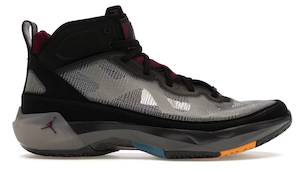
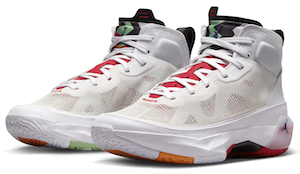
Air Jordan 37
2022
The Air Jordan 37 represents a meticulous approach to performance design, as Jordan Brand collaborates with Nike’s Sport Research Lab, focusing on the three crucial stages of jumping: crash, load, and launch. To address each phase, tailored technologies were incorporated into the shoe’s construction. The flagship Formula 23 foam, in conjunction with a TPU mold at the heel, effectively absorbs the energy from hard landings during the crash stage. For the load phase, a revisit to the carbon fiber midfoot shank from the Air Jordan 32 ensures stability. The launch phase is supported by a Zoom Air strobel unit paired with an additional forefoot unit.
Innovatively, the Air Jordan 37 features an updated Lenoweave, using Arkema yarn for strength and flexibility. The pattern draws inspiration from the Air Jordan 7 and West African basket weaving, creating a layered reduction in design for targeted support. The outsole’s color blocking, reminiscent of the Air Jordan 7, adds a nostalgic touch. The debut “Beyond Borders” colorway, in white, black, purple, and red, is a striking blend, with the classic “Hare” makeover set to follow.
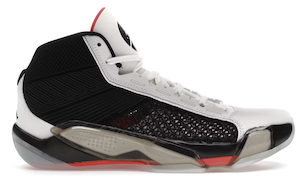
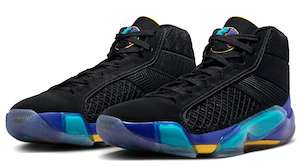
Air Jordan 38
2023
In 2023 the Air Jordan 38 emerged as a meticulously crafted silhouette, paying homage to Michael Jordan’s iconic turnaround fadeaway. Designed from the ground up, the 38 introduces the X-Plate solution, inspired by the Air Jordan 8’s distinctive straps, emphasizing court mobility and space creation. Positioned as a Tier 2 silhouette, the 38 showcases sustainability with at least 20 percent recycled content, evident in the marbled tongue crafted from scraps of sock liners.
Incorporating embroidered technology in the backless forefoot and intricate threaded detailing, the design commemorates Jordan’s 1993 season with 41 crosshatches on the collar, symbolizing his 41-point-per-game average during the Finals, while three diamonds along the medial represent the Chicago Bulls’ third franchise championship. The underfoot experience undergoes a transformation, replacing Formula23 Foam with a full-length Zoom Strobel and Cushlon 3.0 wedge pairing. The radial herringbone traction pattern and the X-Plate contribute to the nostalgic yet purposeful design ethos, completing the Air Jordan 38’s innovative and heritage-inspired profile.

